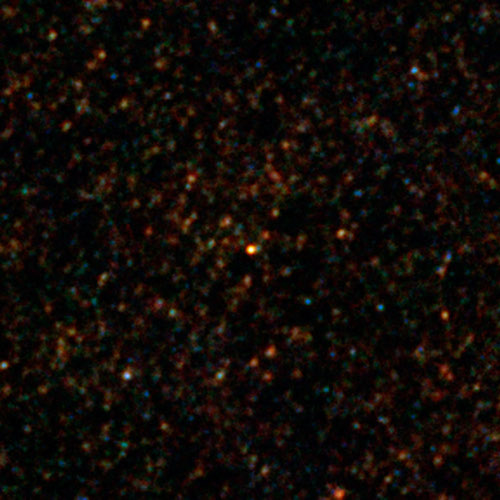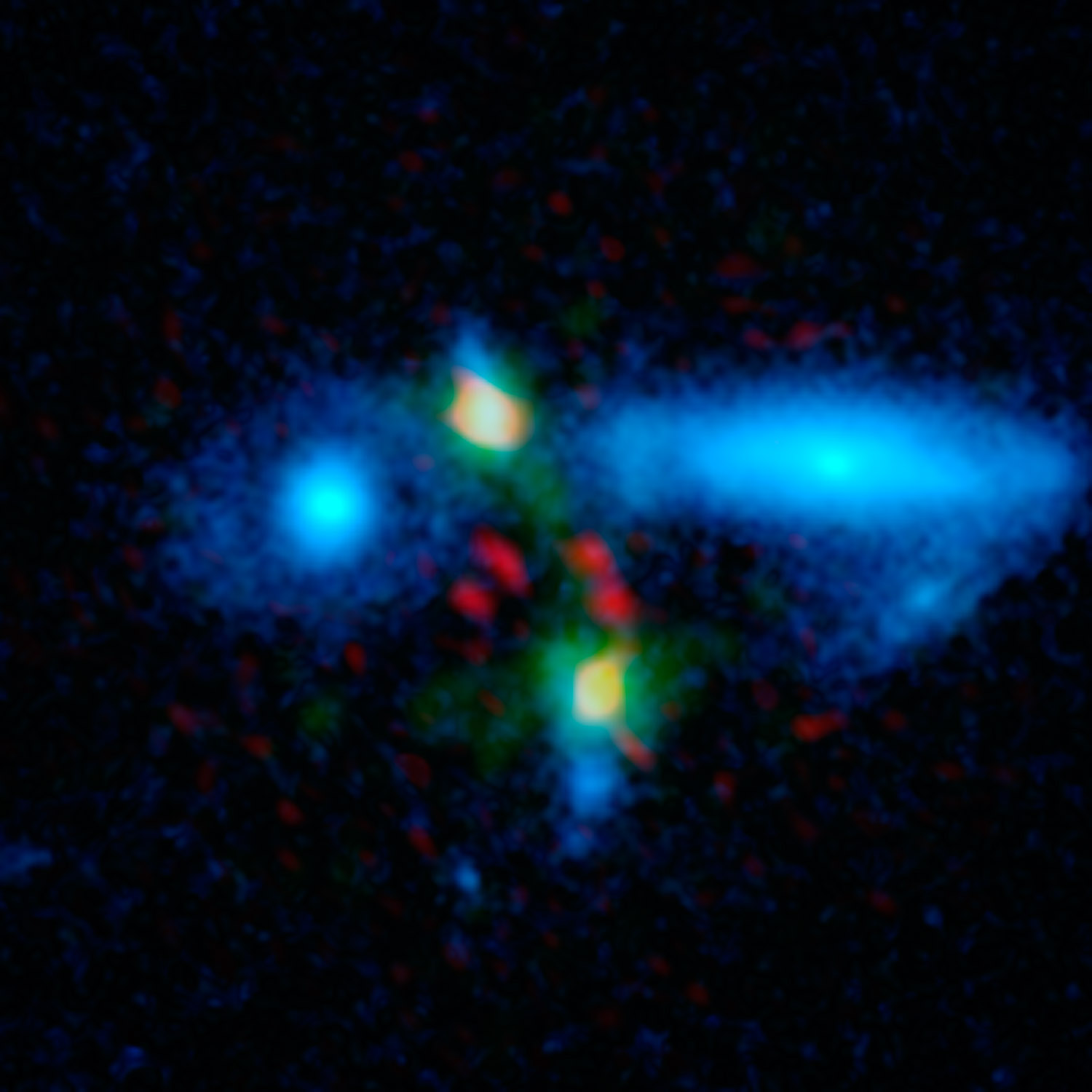| Basic Information | |
| What is this? | Two massive galaxies in the process of merging in the early Universe, seen beyond two much nearer galaxies |
| Where is it in the sky? | In the constellation of Cetus |
| How big is it? | The two merging galaxies are 60,000 light years apart, and will result in a galaxy ten times the mass of our own Milky Way |
| How far away is it? | The galaxies are seen as they were 11 billion years ago, when the Universe was just 3 billion years old |
| What do the colours represent? | The galaxies were seen as a bright red dot in a Herschel image (left). The blue galaxies on the right are much closer interlopers, seen in visible light. The two distant galaxies are seen here in sub-millimetre (red) and radio waves (green) |
Downloads
See this object in:
Herschel has spotted a massive galaxy in the process of forming, providing astronomers with a key missing link in the formation of the most massive galaxies we see around us today.
Galaxies come in two main types: spirals galaxies, like our Milky Way. and elliptical galaxies, which don’t contain such intricate structures. Some of the largest galaxies in the Universe are ellipticals, with some containing many trillions of and weighing in at thousands of times the mass of our own Milky Way. However, there has long been a question over how they built up such a large collection of stars, as they appear to have stopped forming them long ago. One proposal is that they started of relatively large and gradually built up by consuming of lots of smaller galaxies. Another idea is that they are the result of just a couple of two large galaxies colliding – a so-called “major merger”.

The latest discovery was found as a bright red dot in a Herschel image, just one of thousands in a large area of sky studied in the constellation of Cetus the Whale, and goes by the name “HXMM01”. Detailed observations from ground-based telescopes showed that it is was a pair of galaxies, just 60,000 light years apart and in the process of merging together. These galaxies themselves are relatively large, each containing several times as many stars as the Milky Way, but are all but invisible at optical wavelengths, due to thick, obsuring clouds of gas and dust. Herschel, which observed in the far-infrared, is able to see through this dust to the action taking place within.
The galaxies are seen as they were 11 billion years ago, when the Universe was only around 3 billion years old, and the expectation is that they would have merged to form one massive galaxy over the course of the next few hundred million years or so. “These galaxies entered a feeding frenzy, which would have quickly exhausted the food supply in the following hundreds of millions of years, leading to the nrely-forming galaxy’s slow starvation” commented Hai Hu, of University of Irvine, California, and the lead author of the latest paper.
These are forming stars at a prolific rate, equivalent to 2000 suns being born every year – around a thousand times faster than our Milky Way is today. The cause of this rapid starbirth is the huge reservoirs of gas and dust in the galaxies, roughly equal to the mass of the stars currently there. Although it is unclear how they built up such a massive gas supply the expectation is that in a billion year or so, when most of the gas has been converted into stars, the resulting mammoth galaxy will contain the equivalent of 400 billion suns – not far off the most massive galaxies known to exist.
The fact that this is such a quick event, at least by cosmological standards, is why snap-shots of massive galaxies in the process of merging are so hard to find, with only half a dozen or so seen so far at this early stage in the Universe’s evolution. Despite their rarity, such mergers of massive galaxies could play a key role in the formation of the most massive elliptical galaxies we see around us today.
Detailed Information
- Rare merger reveals secrets of galaxy evolution (ESA Portal)
- Rare merger reveals secrets of galaxy evolution (ESA Science & Technology)
- Herschel Space Observatory Finds Galaxy Mega Merger (NASA website)
- Fragile mega-galaxy is missing link in history of cosmos (UC Irvine)

